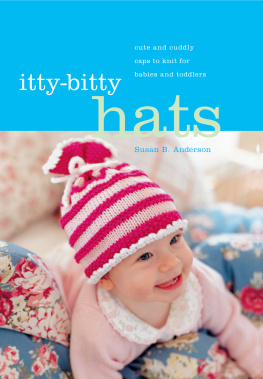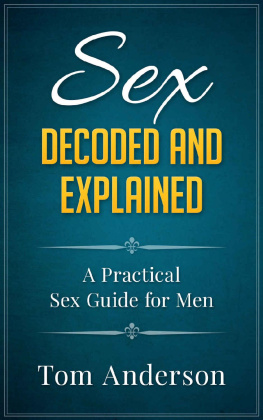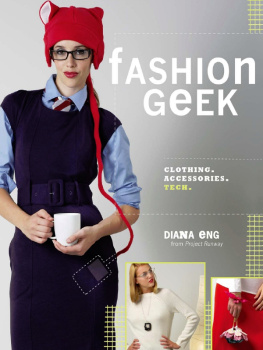Anderson - 50 Nifty Thrifty Upcycled Fashions
Here you can read online Anderson - 50 Nifty Thrifty Upcycled Fashions full text of the book (entire story) in english for free. Download pdf and epub, get meaning, cover and reviews about this ebook. year: 2015, publisher: Stackpole Books, genre: Home and family. Description of the work, (preface) as well as reviews are available. Best literature library LitArk.com created for fans of good reading and offers a wide selection of genres:
Romance novel
Science fiction
Adventure
Detective
Science
History
Home and family
Prose
Art
Politics
Computer
Non-fiction
Religion
Business
Children
Humor
Choose a favorite category and find really read worthwhile books. Enjoy immersion in the world of imagination, feel the emotions of the characters or learn something new for yourself, make an fascinating discovery.
- Book:50 Nifty Thrifty Upcycled Fashions
- Author:
- Publisher:Stackpole Books
- Genre:
- Year:2015
- Rating:4 / 5
- Favourites:Add to favourites
- Your mark:
- 80
- 1
- 2
- 3
- 4
- 5
50 Nifty Thrifty Upcycled Fashions: summary, description and annotation
We offer to read an annotation, description, summary or preface (depends on what the author of the book "50 Nifty Thrifty Upcycled Fashions" wrote himself). If you haven't found the necessary information about the book — write in the comments, we will try to find it.
50 Nifty Thrifty Upcycled Fashions — read online for free the complete book (whole text) full work
Below is the text of the book, divided by pages. System saving the place of the last page read, allows you to conveniently read the book "50 Nifty Thrifty Upcycled Fashions" online for free, without having to search again every time where you left off. Put a bookmark, and you can go to the page where you finished reading at any time.
Font size:
Interval:
Bookmark:

Discover more fresh Craft books, eBooks, and inspiration for your next project!
With detailed, step-by-step photos and clear instruction, Stackpoles craft titles show both beginning and experienced crafters exactly how-to!
Visit
Stackpole Books Crafts & Hobbies webpage

Copyright 2015 by Stackpole Books
Published by
STACKPOLE BOOKS
5067 Ritter Road
Mechanicsburg, PA 17055
www.stackpolebooks.com
All rights reserved, including the right to reproduce this book or portions thereof in any form or by any means, electronic or mechanical, including recording or by any information storage and retrieval system, without permission in writing from the publisher. All inquiries should be addressed to Stackpole Books, 5067 Ritter Road, Mechanicsburg, PA 17055.
Printed in the United States of America
10 9 8 7 6 5 4 3 2 1
First edition
Cover design by Wendy A. Reynolds
Photography by Tiffany Blackstone and Cynthia Anderson
Illustrations by Cynthia Anderson
Library of Congress Cataloging-in-Publication Data
Anderson, Cynthia (Seamstress)
50 nifty thrifty upcycled fashions : sew something from nothing / Cynthia
Anderson. First edition.
pages cm
ISBN 978-0-8117-1470-9
1. Clothing and dressRemaking. 2. Textile crafts. 3. Textile wasteRecycling.
I. Title. II. Title: Fifty nifty thrifty upcycled fashions.
TT550.A53 2015
646.4dc23
2015011116
eBook ISBN 978-0-8117-6240-3

Upcycling 101
What is Upcycling?
Upcycling is the process of taking things you would throw away and making them into something useful without negatively impacting the environment. It is different from recycling in that it makes good use of limited resources, saves the energy costs and climate impact of recycling, and stretches your creativity. Upcycling old clothing is not just creating wearable art, it is designing and producing actual wearable clothing as well. It is a way for the artist to express inner creativity in a practical, yet whimsical way.
Why Go Green?
Do you have a clue how much clothing goes to the landfill every year? According to the EPA, 85 percent of unwanted clothing is discarded and accounts for more than 4 percent of municipal solid waste volume. The EPA Office of Solid Waste reports that Americans throw away more than sixty-eight pounds of clothing and textiles per person per year. In 2005 the volume of discarded clothing in the United States was eight million tons. It has continued to increase since then.
Stop throwing it away right now! Extend the life of out-of-style, ill-fitting fashions by refashioning them. Give your old clothes a second chance. Even if the label says dry clean only, wash and dry it and redesign it into something more practical, stylish, and usable.
Essence of Thrift
Upcycling is a way of life that honors thrift. It is based on a triage of spending that is the essence of thrift. Start by using what you have and move up from there.
Buy
Make
Thrift
Swap
Borrow
Use what you have
Make Something from Nothing
Youll spend less and leave a smaller carbon footprint by making something of greater value out of something you either already own or can buy at the thrift store for next to nothing. Six or eight worn T-shirts cut and sewn together make a smashing new wraparound skirt (.
Upcycling allows you to incorporate into your projects bits and bobs and pieces of history as tangible symbols of family heritage. A button from great-grandfathers WWII uniform, pockets made from dads silk graduation tie, or a piece of lace from mothers wedding dressit is so satisfying to tuck a family memento into an upcycled work of art!

Wabi Sabi
Wabi Sabi is a Japanese aesthetic that embraces the nature of the impermanent, of imperfection and the transient. It honors finding beauty in nature and accepting that there is a natural progression of growth, decay, and death. Wabi Sabi embraces that which is aged, worn, and shows the wages of time and wear. Wabi Sabi would be shopping at thrift stores and flea markets, not shopping at the mall. Keep this concept in mind as you work on these upcycling projects. None will be perfect and none will last forever. Things you upcycle wont be perfectly symmetrical, they wont be permanent, and they wont be costly. They will be ingenious and stylish, and will give you great personal satisfaction.
Basic Materials and Equipment
Best Sources for Upcycling Fodder
First of all, you need old or unwanted clothes to work with: old sweaters, dresses, suit coats, dress shirts, and so on. You'll also want a stock of table linens, handkerchiefs, dresser scarves, pillowcases, and other old fabric items, both to use in the projects in Chapters 7 and 8 and as sources for gorgeous old embroidery, lace trims, and fabric scraps for linings. Almost any castoff item can be used in some way!
Your familys closets are the first best source for items to upcycle. Of course, giving unwanted or outgrown clothing to a friend or charity thrift store is another way to clear out your closet. But many items aren't suitable for this use. Set aside items that are:
stained
too worn
torn or moth-eaten
too warm or too cool for your climate
seriously outdated
Such items will bring no value to the resale shop, and would likely just end up in the landfill anyway. But you can give them new value by creating something fabulous out of them.
After you raid your own and your familys and friends closets for unwanted items, try the following sources for more upcycling fodder:
thrift stores
clothing exchanges
resale/consignment shops
lost and found departments
yard sales, estate sales, tag sales, and garage sales
You could even form a small group of fashion upcyclers and trade among yourselves! You'll find cheap materials to craft with as well as reducing the amount of solid waste going to landfills.

Preparing the Fabrics for Production
Always wash your found clothing and linens before you upcycle them. Sometimes the item is so old and so fragile that it disintegrates as you wash it. While this is heartbreaking, it is better to know it cant be used before you have invested time and energy in transforming it into something new.
Exceptions to the wash-first rule might be centuries-old textiles or fabrics that you can see are already shredding without touching the water. These fabrics arent a good choice for projects that will be worn regularly, but if you are making an item that will be used on one occasionsuch as a brides dressand then saved as an heirloom, working a piece of fragile antique textile into a project works great.
Wash the cottons and linens by hand. Presoak them in a chlorine-free spot remover to get rid of as many stains as possible.
To felt wool sweaters, machine-wash them in color groups and dry them in the dryer. If you have just one sweater to felt, you can boil it in a big pot on the stove, stirring frequently and vigorously until it is felted as much as you want. Store the felted sweaters by color in big plastic tubs or self-closing bags.
Next pageFont size:
Interval:
Bookmark:
Similar books «50 Nifty Thrifty Upcycled Fashions»
Look at similar books to 50 Nifty Thrifty Upcycled Fashions. We have selected literature similar in name and meaning in the hope of providing readers with more options to find new, interesting, not yet read works.
Discussion, reviews of the book 50 Nifty Thrifty Upcycled Fashions and just readers' own opinions. Leave your comments, write what you think about the work, its meaning or the main characters. Specify what exactly you liked and what you didn't like, and why you think so.















